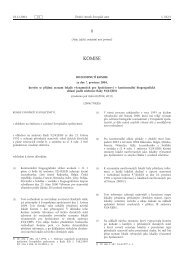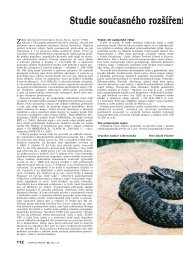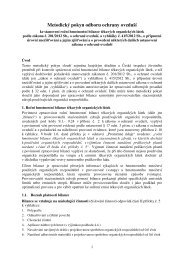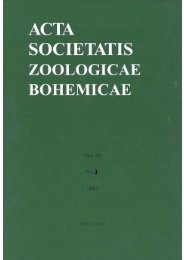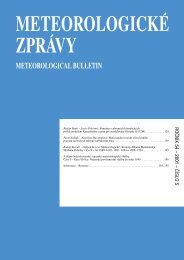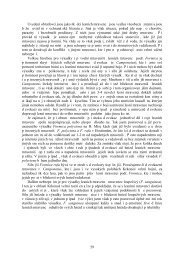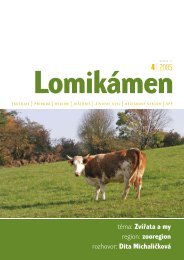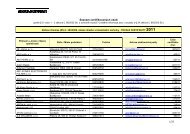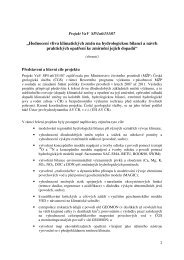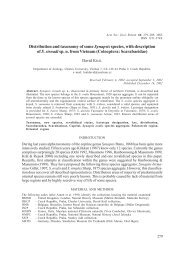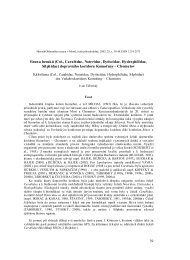journal of forest science
journal of forest science
journal of forest science
Create successful ePaper yourself
Turn your PDF publications into a flip-book with our unique Google optimized e-Paper software.
parameter estimates are used to form a consistent estimate<br />
<strong>of</strong> the covariance matrix <strong>of</strong> the disturbances, which<br />
is then used as a weighting matrix when the model is reestimated<br />
to obtain new values <strong>of</strong> the parameters. These<br />
estimates are consistent and asymptotically normal, and<br />
under certain conditions, asymptotically more efficient<br />
than the single equation estimates.<br />
(ii) System <strong>of</strong> recursive equations:<br />
If B is triangular, that is if:<br />
B11 B21 B = .<br />
.<br />
B G1<br />
0 ........ 0<br />
B ...... 0<br />
22<br />
B G2 ...... B GG<br />
The system is known as a recursive system <strong>of</strong> equations.<br />
The system <strong>of</strong> recursive equations is a simultaneous<br />
set <strong>of</strong> regression equations fitted one at a time in a logical<br />
sequential order. The general condition that must be<br />
met to define a system <strong>of</strong> recursive equations is that the<br />
B matrix must be triangular (KMENTA 1971). That means<br />
a necessary condition for the recursive system to be estimated<br />
is that it is algebraically complete from the standpoint<br />
that the number <strong>of</strong> equations must equal the number<br />
<strong>of</strong> endogenous variables. In this case the solution for the<br />
gth endogenous variable involves only the first g structural<br />
equations. This means that all G structural equations<br />
are needed for the solution only in the case <strong>of</strong> the<br />
last endogenous variable Y Gt . Notice that the first structural<br />
equation involves only one endogenous variable.<br />
or this type <strong>of</strong> equation system, ordinary least squares<br />
(OLS) can be used to obtain parameter estimates if there<br />
is no cross-equation correlation between error components<br />
<strong>of</strong> the various equations in the system (BORDERS<br />
1989; LIU et al. 1989). In the strict definition <strong>of</strong> a recursive<br />
system, there is no correlation problem between the<br />
RHS endogenous variables and the error components <strong>of</strong><br />
the LHS endogenous variables. However, this assumption<br />
relies on the fact that the error components for the<br />
equation in a recursive system are pair-wise unrelated.<br />
When such correlations exist, it is not true that RHS endogenous<br />
variables are not correlated with error components<br />
<strong>of</strong> LHS endogenous variables. Therefore, when<br />
cross-equation correlations exist in a system <strong>of</strong> recursive<br />
equations, the system is not recursive by definition (BOR-<br />
DERS 1989). Three-stage least squares (3SLS) and SUR<br />
estimation methods in econometrics must be used to estimate<br />
the parameters <strong>of</strong> the system.<br />
(iii) System <strong>of</strong> simultaneous equations:<br />
If B is neither diagonal nor triangular, it is defined as<br />
an integrated structure, or a system <strong>of</strong> simultaneous equations.<br />
A simultaneously interdependent system <strong>of</strong> equations<br />
exists when two or more variables in the system are<br />
jointly determined by the phenomenon being modelled<br />
in a system <strong>of</strong> interrelated equations, that means no logical<br />
sequential ordering <strong>of</strong> equations exists. A logical<br />
sequential ordering <strong>of</strong> equations appears unlike in (1) and<br />
(2) discussed above. Such structures have commanded<br />
the greatest attention and provided the main subject for<br />
discussion in <strong>forest</strong> biometrics (AMATEIS et al. 1984;<br />
BORDERS, BAILEY 1986; BORDERS 1989). The relationships<br />
in such a system can be complex and may consist<br />
<strong>of</strong> variables that appear as both regressors and dependent<br />
variables as well as cross-equation correlations between<br />
error components. urthermore, restrictions may<br />
be placed on parameters both within and across equations<br />
(BORDERS, BAILEY 1986; LYNCH, MURPHY<br />
1995). Seemingly unrelated regression (SUR) and threestage<br />
least squares (3SLS) from econometrics can be used<br />
to obtain consistent and asymptotically efficient parameter<br />
estimators for simultaneous systems.<br />
SYSTEM O ESTIMATED EQUATIONS<br />
A system <strong>of</strong> three equations for eucalyptus plantation<br />
stands was selected for this analysis:<br />
V2 = V1 e [a1(1/t2 – 1/t1) + a2(1/H2 – 1/H1) + a3(lnG2 – lnG1)] + ε1 (1)<br />
G2 = e [(t1/t2)lnG1 + cl(1 – t1/t2) + c2(1 – H1/H2)] + ε2 (2)<br />
H2 = b0 {1 – [ln(1 – e– b1t2 )]/[ln(1 – e – b1t1 )]} [ln(1 – e H1 – b1t2 )/ln(1 –b1t1 )] + ε3 (3)<br />
where: Vi is stand volume yield at time ti (m 3 /ha), Gi is stand<br />
basal area at time ti (m 2 /ha), Hi is stand dominant height at<br />
time ti (m), e is the base <strong>of</strong> natural logarithm (= 2.71828), ε1,<br />
ε2 and ε3 are error terms for equations (1), (2) and (3), respectively,<br />
a 1 –a 3 , c 1 –c 2 and b 0 –b 1 are parameters to be estimated.<br />
The system <strong>of</strong> equations (1)–(3) regards stand volume<br />
yield, stand basal area and stand dominant height increment<br />
predictions as being simultaneous and interdependent.<br />
It is clear that within this system, variables G2 and<br />
H2 appear on the left-hand side (LHS) <strong>of</strong> the equations<br />
as well as on the right-hand side (RHS) <strong>of</strong> the equations<br />
in the system. Together with V2, they are the system outputs<br />
and are regarded as endogenous variables that are<br />
jointly determined by the joint inter-independence with<br />
other variables within the system. Variables that appear<br />
only on the RHS <strong>of</strong> the equations in the system are regarded<br />
as exogenous or predetermined variables. Their<br />
values are known and are not determined by the structure<br />
<strong>of</strong> the system.<br />
As mentioned above, endogenous variables can occur<br />
on both the RHS and the LHS <strong>of</strong> an equation, and hence<br />
they are stochastic. The presence <strong>of</strong> endogenous variables<br />
in the system violates the independence assumption <strong>of</strong><br />
OLS. In OLS, variables on the RHS are assumed to be<br />
uncorrelated with the error terms, and in fact they are<br />
usually assumed to be known constants. When stochastic<br />
variables appear in regression equations as predetermined<br />
variables on the RHS, there can no longer be<br />
independence between the RHS variables and the error<br />
terms <strong>of</strong> the equations (JUDGE et al. 1985). Since G2<br />
depends on H2, and the observed value <strong>of</strong> H2 depends<br />
on the error terms ε3 application <strong>of</strong> OLS estimation techniques<br />
to equations (1)–(3) will yield biases and inconsistent<br />
parameter estimates, because <strong>of</strong> the obvious<br />
J. FOR. SCI., 47, 2001 (7): 285–293 287



